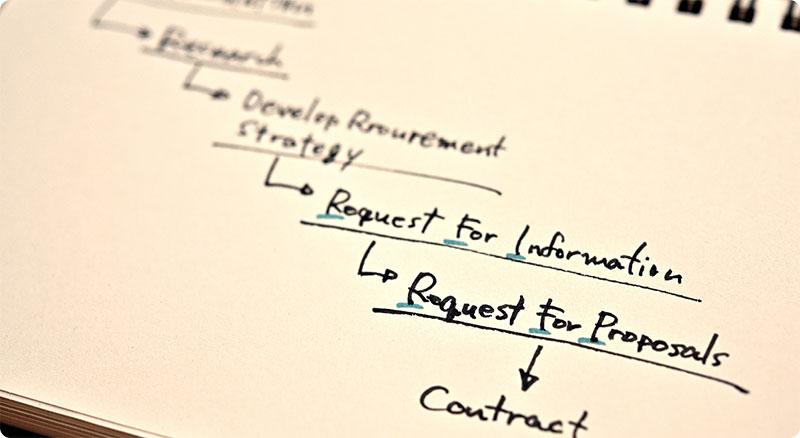RESOURCES
RFP BEST PRACTICES: A COMPREHENSIVE GUIDE TO CRAFTING EFFECTIVE RFPS

INTRODUCTION
The Request for Proposal (RFP) stands as an irreplaceable tool in the procurement process, guiding organizations in identifying the most suitable vendors for their projects. The art of crafting an effective RFP is nuanced; it calls for clarity, precision, and a deep understanding of your project's needs. In this comprehensive guide, we aim to delineate best practices for creating an RFP that will draw in high-quality, competitive bids and set your project on a trajectory towards success.
UNDERSTANDING THE IMPORTANCE OF AN RFP IN PROCUREMENT
Before diving into the specifics of creating a robust RFP, it's crucial to understand its importance in the procurement process. An RFP serves as a critical communication tool between your organization and potential vendors. It outlines your project's needs, defines your expectations, and sets a clear benchmark for what potential vendors must achieve. Moreover, a well-crafted RFP can help reduce the risk of project failure by ensuring that vendors are clear about project requirements and deliverables.
CLEARLY DEFINE YOUR NEEDS
At the heart of a successful RFP is a lucid definition of the project's needs. Strive for clarity and specificity about what you aim to achieve, the services or products required, the expected timeline, and any other crucial details. A detailed RFP will attract bids from vendors who are confident in their ability to meet your requirements, thereby ensuring a higher quality of responses.


SET CRITERIA FOR EVALUATION
Building an evaluation framework is a pivotal step in the RFP process. Establish clear criteria for evaluating bids, including aspects such as pricing, vendor experience, approach to the project, and quality of work. Having clear evaluation criteria not only aids in objectivity when comparing bids but also ensures you can identify and select the bid that offers the most significant value for your organization.
PROVIDE DETAILED INSTRUCTIONS
The next step in crafting a compelling RFP is to provide comprehensive instructions for how vendors should respond. This includes specifying the response format, the information vendors should include, any specific questions they need to answer, and the deadline for submission. Clear, detailed instructions will enable vendors to provide the information you need to make an informed decision.
CULTIVATING OPEN COMMUNICATION WITH POTENTIAL VENDORS
Ensuring open lines of communication with potential vendors is vital to receiving responses that align with your project needs. This might entail hosting a pre-bid meeting or conference call to clarify any uncertainties, or providing a point of contact for any questions. Effective communication can yield better responses, as vendors will have a deeper understanding of what you're seeking.
WALKING IN THE VENDOR'S SHOES
When drafting an RFP, remember to consider the vendor's perspective. Ensure that the process is fair and the project is feasible within the constraints you set. Strive to create an RFP that results in a win-win situation for both parties. This approach not only increases the likelihood of getting high-quality responses but also strengthens your relationship with vendors, paving the way for successful collaborations.
FOSTERING INNOVATION IN THE RFP PROCESS
While it's essential to be clear about your project's needs, remember to leave room for creativity. Avoid being too prescriptive in your requirements and welcome vendors to propose innovative solutions you may not have considered. Allowing for innovation can lead to better project outcomes and provide valuable insights into a vendor's ability to think creatively and strategically.
INCORPORATING FEEDBACK IN THE RFP PROCESS
Feedback plays a crucial role in improving the quality of your RFPs. Consider seeking feedback from vendors who chose not to bid or were not selected. They might provide valuable insights into how you can make your RFPs more attractive and clearer. Remember, the goal is continuous improvement.


DEVELOPING A TIMELINE FOR THE RFP PROCESS
Another best practice is to develop a clear timeline for the RFP process. This timeline should include milestones such as when the RFP will be issued, the deadline for questions, the closing date for proposals, and the date by which the successful bidder will be notified. A well-planned timeline ensures that all parties involved are synchronized and have clear expectations.
CONCLUSION
Crafting an effective RFP is a critical phase in the procurement process. It's about striking the right balance between providing ample detail to guide potential vendors and allowing room for them to exhibit their capabilities. By integrating these best practices, you can develop RFPs that draw high-quality, competitive bids, leading to prosperous procurement outcomes. Remember, an RFP is more than just a tool; it's a strategic asset that, when used effectively, can lead to successful projects and long-term vendor relationships.






